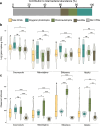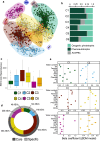Uncovering diversity and abundance patterns of CO2-fixing microorganisms in peatlands
- PMID: 40760046
- PMCID: PMC12322008
- DOI: 10.1038/s44185-025-00099-1
Uncovering diversity and abundance patterns of CO2-fixing microorganisms in peatlands
Abstract
Microorganisms play a crucial role in the carbon (C) dynamics of peatlands - a major terrestrial C reservoir. Because of their role in C emissions, heterotrophic microorganisms have attracted much attention over the past decades. CO2-fixing microorganisms (CFMs) remained largely overlooked, while they could attenuate C emissions. Here, we use metabarcoding and digital droplet PCR to survey microorganisms that potentially fix CO2 in different peatlands. We demonstrate that CFMs are abundant and diverse in peatlands, with on average 1021 CFMs contributing up to 40% of the total bacterial abundance. Using a joint-species distribution model, we identified a core and a specific CFM microbiome, the latter being influenced by temperature and nutrients. Our findings highlight that ASV richness and community structure were direct drivers of CFM abundance, while environmental parameters were indirect drivers. These results provide the basis for a better understanding of the role of CFMs in peatland C cycle inputs.
© 2025. The Author(s).
Conflict of interest statement
Competing interests: The authors declare no competing interests.
Figures






Similar articles
-
"In a State of Flow": A Qualitative Examination of Autistic Adults' Phenomenological Experiences of Task Immersion.Autism Adulthood. 2024 Sep 16;6(3):362-373. doi: 10.1089/aut.2023.0032. eCollection 2024 Sep. Autism Adulthood. 2024. PMID: 39371355
-
Fabricating mice and dementia: opening up relations in multi-species research.In: Jenkins N, Jack-Waugh A, Ritchie L, editors. Multi-Species Dementia Studies. Bristol (UK): Bristol University Press; 2025 Feb 25. Chapter 2. In: Jenkins N, Jack-Waugh A, Ritchie L, editors. Multi-Species Dementia Studies. Bristol (UK): Bristol University Press; 2025 Feb 25. Chapter 2. PMID: 40690569 Free Books & Documents. Review.
-
Impact of study design, contamination, and data characteristics on results and interpretation of microbiome studies.mSystems. 2025 Aug 6:e0040825. doi: 10.1128/msystems.00408-25. Online ahead of print. mSystems. 2025. PMID: 40767516
-
Barriers and facilitators to the implementation of lay health worker programmes to improve access to maternal and child health: qualitative evidence synthesis.Cochrane Database Syst Rev. 2013 Oct 8;2013(10):CD010414. doi: 10.1002/14651858.CD010414.pub2. Cochrane Database Syst Rev. 2013. PMID: 24101553 Free PMC article.
-
Digital interventions in mental health: evidence syntheses and economic modelling.Health Technol Assess. 2022 Jan;26(1):1-182. doi: 10.3310/RCTI6942. Health Technol Assess. 2022. PMID: 35048909 Free PMC article.
References
-
- Nichols, J. E. & Peteet, D. M. Rapid expansion of northern peatlands and doubled estimate of carbon storage. Nat. Geosci.12, 917–921 (2019).
-
- Rydin, H. & Jeglum, J. K. The biology of peatlands. 10.1093/ACPROF:OSO/9780198528722.001.0001 (2006).
-
- Strack, M., Davidson, S. J., Hirano, T. & Dunn, C. The potential of peatlands as nature-based climate solutions. Curr. Clim. Change Rep.8, 71–82 (2022).
-
- Hamard, S., Küttim, M., Céréghino, R. & Jassey, V. E. J. Peatland microhabitat heterogeneity drives phototrophic microbe distribution and photosynthetic activity. Environ. Microbiol.23, 6811–6827 (2021). - PubMed
Grants and funding
LinkOut - more resources
Full Text Sources
Miscellaneous

